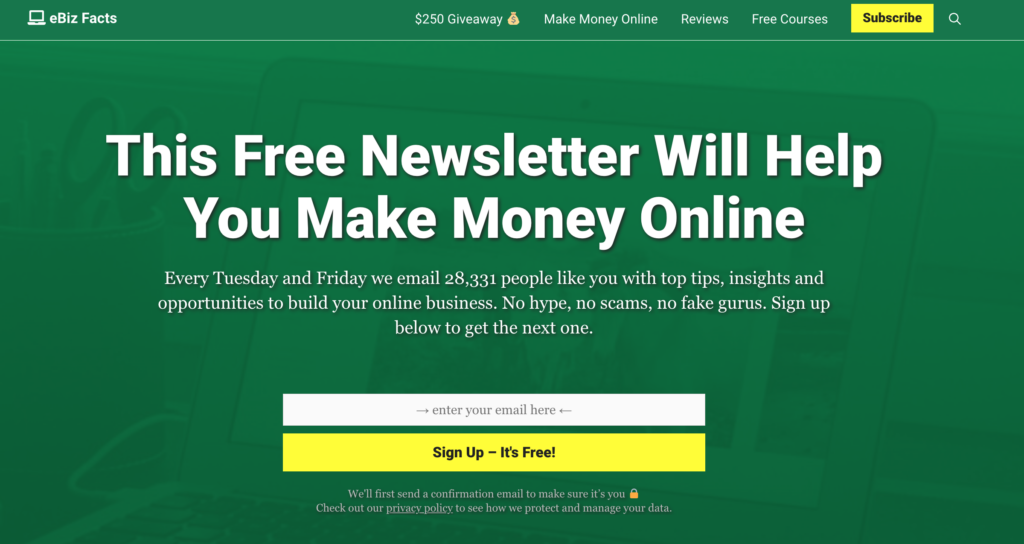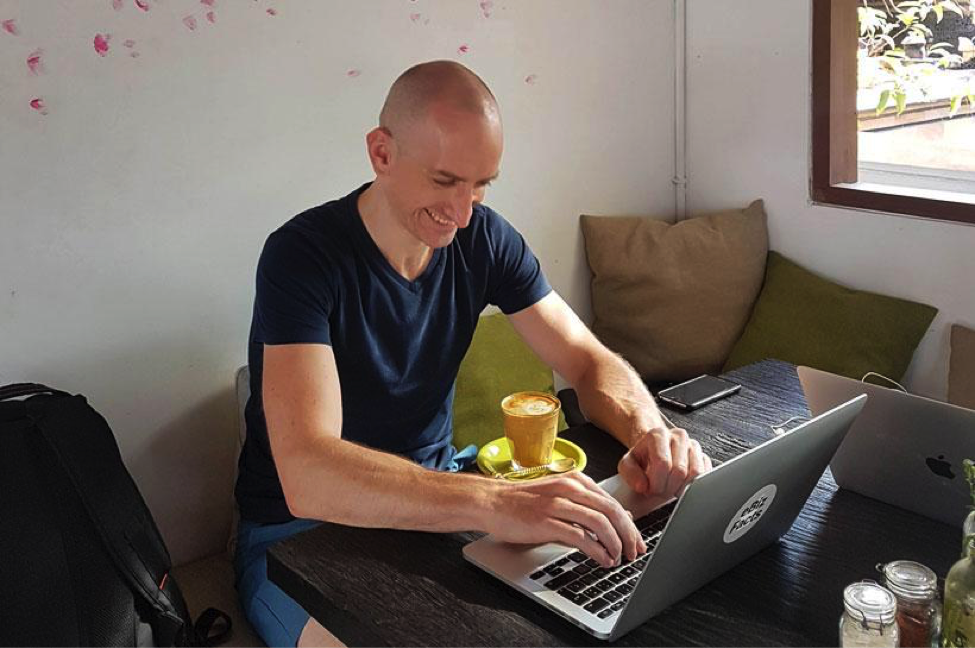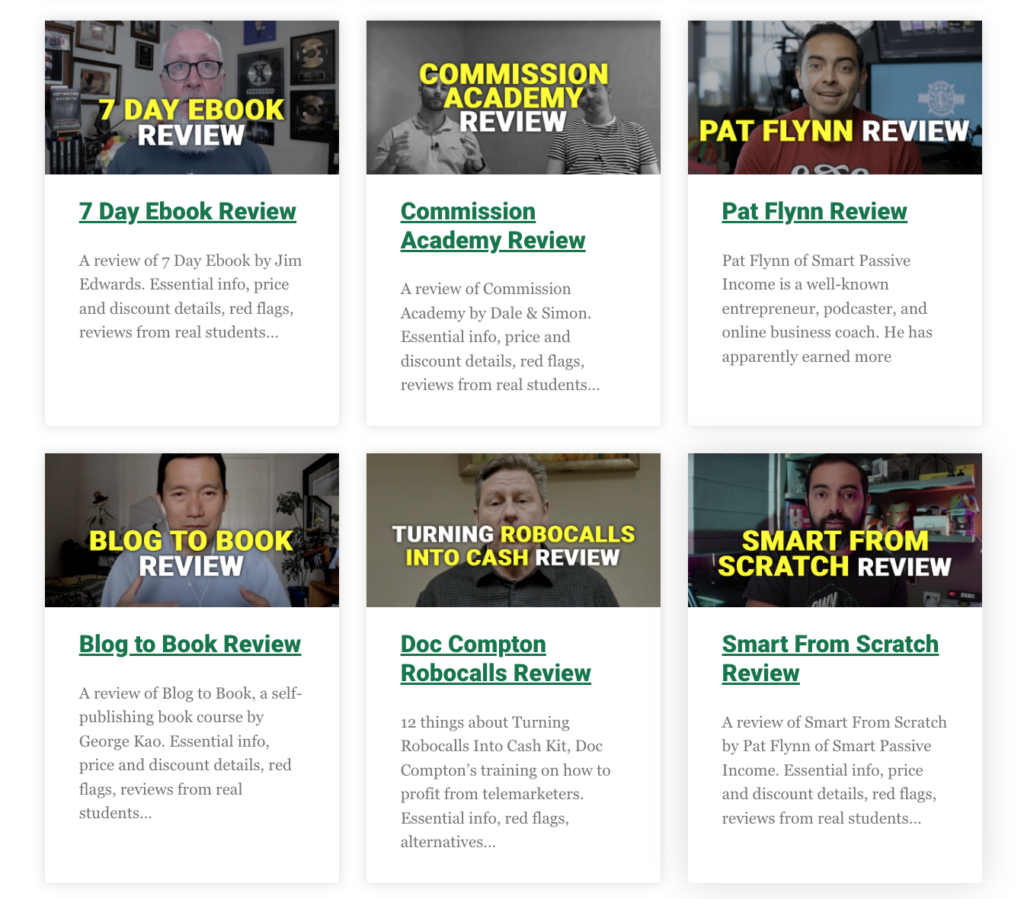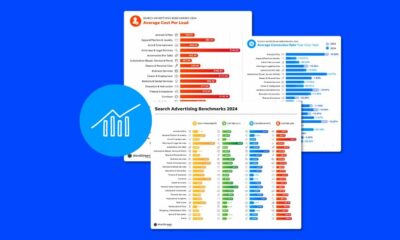AFFILIATE MARKETING
How This 40-Year-Old Earns $15k/Month Sharing User-Generated Reviews of Online Courses

Niall Doherty has always been one to think outside the box—whether it’s his lifestyle choices or his business ideas.
For example, for 3+ years, he traveled the world but never set foot on an airplane. Most recently, he settled down in one of the world’s smallest countries.
And from an entrepreneurial standpoint, he built a website called eBiz Facts. He created a system for reviewing online courses that is completely one-of-a-kind because it is brutally honest and includes user-generated reviews.
Today he’s taking home $15k/month, and he’s just getting started.
Keep reading to find out
- How he got into affiliate marketing
- What his initial idea for his website was
- What his review process entails
- What makes his reviews unique
- What sometimes happens when he publishes a negative review
- His main approach to marketing
- His SEO strategy
- How he does keyword research and creates content
- His future plans for his email list
- His favorite resources and tools
- His biggest challenge
- The accomplishment he’s most proud of
- His main mistake
- The advice he would give to other entrepreneurs
Meet Niall Doherty
I’m 40 years old and from Ireland, but I currently live in the tiny country of Andorra (it’s hidden away in the mountains between France and Spain).
I haven’t spent much time in Ireland in the last 15 years or so. My last 9-to-5 job was as a web designer for a university in New Orleans. I quit that job in 2010 to work for myself and travel the world.
I spent most of the next decade doing the digital nomad thing, including a 3.5-year stretch where I circumnavigated the globe without flying.
During that time, I made my living mostly as a freelance web designer.
I got married last year and decided to settle down in Andorra and build a nice home base here.
Why He Created eBiz Facts
Before starting eBiz Facts, I had been running an online course for a few years, teaching people how to travel the world and work online as a freelancer like I had been doing. That course did okay but never gave me a great ROI, so I was looking for something different.

A friend of mine had had some great success with a niche site, and the way he described the business model appealed to me: just write great content and monetize with affiliate offers where it makes sense.
I decided to do that for the “make money online” niche, so eBiz Facts was born at the end of 2018.
The big idea initially was to do in-depth, carefully researched, and brutally honest reviews of “make money online” courses and gurus. The first person I looked at was Tai Lopez. I spent about six weeks researching him, consuming his content, buying his courses, and combing through his materials.
Ultimately I published 6 articles and reviews about Tai Lopez and his courses, amounting to more than 20,000 words, and a couple of YouTube videos. I rated one of his courses quite low and gave another a decent rating. I was an affiliate for Tai, and I worried I might get kicked out of his affiliate program for being too honest with my content, but they didn’t seem to have a problem with it.
I remember seeing the first affiliate commission come through a day after I published all the content. It was only $15, but it felt amazing. I was sure I was onto something.

Since then, I’ve published many more reviews of other courses and earned $500,000+ in affiliate commissions.
At the start of 2021, I changed my review process significantly.
I now have a 31-factor process for evaluating and rating each course. And we also collect and publish ratings and reviews from students, combining their insights with our own to arrive at a fair and accurate overall rating for each course.
The Impact of Honest Reviews
Something unusual about the business is that we’ve been threatened with lawsuits multiple times. Some course creators have taken exception to our critiques of their courses and responded with legal threats. Those experiences have been stressful, but ultimately nothing came of them.
We’ve also been kicked out of numerous affiliate programs, usually for being too critical of a course. Most course creators are used to affiliates saying nothing but nice things and going to great lengths to convince people to sign up for their courses. But our rating of a course isn’t determined by whether or not we have an affiliate partnership with the course creator.

That often costs us money in the short term – for a long time, one of our top-rated courses didn’t even have an affiliate program – but I like to think it builds trust with readers and leaves us better off in the long run.
How Much Money Niall is Making
I’ve been publishing monthly finance reports on my website since 2011, so you can see the exact progression of my business there.
In the past six months, eBiz Facts has averaged $19,102 in monthly revenue and $5,042 in monthly expenses. About 95% of the revenue comes from affiliate commissions.
A good chunk of the expenses these days is for hired help. Last year I transitioned the business from being mostly a one-man operation to having a team of 5 contractors assisting me regularly.
His Top Marketing Strategy
Search Engine Optimization is how we get the vast majority of our traffic. We rank quite well for course review keywords.
If we are an affiliate for a course, we have a big CTA at the top of the review, regardless of the rating.
Since starting eBiz Facts I’ve also put out a weekly newsletter (as of a few weeks ago, it’s twice weekly).
A Unique Strategy That Works for Niall
No other review site in our niche does crowd-sourced reviews. Or, at least, they don’t do it well. And I understand why: it’s way easier to just write up a review of a course yourself.
But I believe the ideal experience for someone interested in buying a course is to see a bunch of well-curated and insightful reviews from real students. So that’s what we try to provide on eBiz Facts, together with a well-researched editorial review that gives a handy overview of the course, the pros and cons, the alternatives, etc.
Finding real students for each course and convincing them to leave reviews has been tough, but ultimately I feel our content is much better because of it.
The Importance of SEO
SEO is crucial for our business.
I would simplify our strategy down to these bullet points:
- Quick keyword research via Ahrefs to figure out what courses to review
- Research the courses and publish the reviews
- Collect and publish student reviews
- Wait a couple of months
- Use recommendations from Surfer SEO to tweak the review and improve rankings
Keyword Research
We keep it very simple.
If a course review keyword seems to have decent search traffic, according to Ahrefs, we’ll at least publish a “stub review” of that course.
A stub review is a short piece of content with only factual info about the course, without a judgment or rating.
We’ll let that sit there for a few months and see how it ranks or if it brings in much traffic. Usually, the results there is a good indication that it would be worthwhile to write up a full editorial review and make the effort to collect student reviews.
Link Building
We barely do any active link building.
eBiz Facts has a pretty good backlink profile, though. A lot of that is due to the site originally being my personal travel and personal development blog. That picked a lot of nice links organically over the years, giving the site a good headstart when I repurposed it into eBiz Facts.
Lately, we have been making more of an effort to get our site listed on various directories and to partake in more interviews like this one, but it still feels like we could be doing way more here.
His Content Creation Process
We have a 31-factor process for each editorial review. So we go through the course – usually, we’ll have access to it – and evaluate it based on those factors.
Our scores there feed into an algorithm that spits out an editorial rating of the course.
Then we write up our review of the course based on a template. That usually goes through 1-2 rounds of revisions before I’m happy to publish it.
Once published, we go to work finding and “recruiting” students of the course to add their reviews. We also have a complex algorithm for their reviews, which determines how much impact their course rating has on the overall course rating.
His Email List
I send out a twice-weekly newsletter to 28,000+ people.
I share tips, opportunities, and inspiration for building an online business in each edition.
I only recently started monetizing the newsletter directly. It may become a significant source of revenue down the line, but the main reason for starting it was to build up an audience that Google couldn’t take away from me with a change in their algorithm.
Growth of that list has mainly been via SEO. When someone comes to the website, they’ll usually see an email opt-in encouraging them to sign up.
Recently we’ve been working to repurpose the newsletter content and post it on social media. We’re starting to see some results from that.
How Much He Works on His Business
I track all my work hours, and for the past several months, I’ve averaged 92 hours per month, so about 21 hours per week.
This is strange because it feels like I work much more than that!

How Long it Took to Reach His Current Earnings
I started eBiz Facts at the end of 2018, and it didn’t earn much affiliate income for the first year. I believe it was less than $10,000 for the entire year, and $4000 came in a single month.
The business really started to take off in 2020. I believe it was the combination of all the work I’d put into it the year before, combined with many more people looking to make money online during the pandemic.
July 2020 was the first month I cracked the $10k mark, earning more than $18,000 overall. Revenue has been pretty consistently around $15k/month since then.
Niall’s Favorite Resources
The main course I’ve followed to build eBiz Facts is The Authority Site System (TASS) by Authority Hacker. I learned a ton from that about SEO and how to create great content.
The course was great back when I started, and they update it regularly, so it’s still really valuable.
His Top 3 Tools
ClickUp is the #1 tool I use every day. I organize my entire life there, both business tasks and personal. It’s great for collaboration, really powerful, and flexible.
Ahrefs and Surfer are my weapons of choice for SEO.
We use Jotform for collecting student reviews, and that’s really handy.
His Greatest Challenge
I would say it’s constantly feeling overwhelmed.
Because there is always more I could be doing, and it’s easy to feel like I should be doing those things and making faster progress.
This year I’m trying to relax a bit and not stress myself out so much, feeling like I always need to do more, more, more.
Niall’s Main Accomplishment
I quit my last 9-to-5 job in 2010, so I’ve been doing my own thing for over a decade now and earning enough money to do everything I’ve wanted to do.
Working for myself online has given me the freedom to travel the world, work on my own schedule, and follow my interests… and more recently, it’s enabled my wife and I to move to a country we love (Andorra) and start a new life here.
What He Wishes He Knew When He Started
I wish I had known not to be so idealistic.
Idealism can be great, but it can also hold you back. It has held me back many times because I often felt something needed to be perfect before I could push publish. I was too scared of making mistakes.
Nowadays, I try more things and probably fail more than I did back when I was starting out. But I learn from those failures and adjust course.
His Biggest Mistake
Going way back to when I started working for myself, my biggest mistake was chasing passive income. I’d read in books like The 4-Hour Workweek that you should avoid trading time for money and focus on passive income streams instead. That led to me wasting a lot of time and effort.
It was several months before I embraced freelance web design, and that became my most reliable source of income for several years.
His Advice for Other Entrepreneurs
If someone is just starting out and have yet to make any money online, I strongly recommend starting with freelancing or a remote job.
You’ll gain a ton of experience and earn while learning.
Eventually, you’ll be good enough to increase your pay and reduce your hours, thus giving you the time and financial freedom to pursue business ideas that can ultimately generate millions of dollars and/or passive income.
SOCIAL
12 Proven Methods to Make Money Blogging in 2024

 This is a contributed article.
This is a contributed article.
The world of blogging continues to thrive in 2024, offering a compelling avenue for creative minds to share their knowledge, build an audience, and even turn their passion into profit. Whether you’re a seasoned blogger or just starting, there are numerous effective strategies to monetize your blog and achieve financial success. Here, we delve into 12 proven methods to make money blogging in 2024:
1. Embrace Niche Expertise:
Standing out in the vast blogosphere requires focus. Carving a niche allows you to cater to a specific audience with targeted content. This not only builds a loyal following but also positions you as an authority in your chosen field. Whether it’s gardening techniques, travel hacking tips, or the intricacies of cryptocurrency, delve deep into a subject you’re passionate and knowledgeable about. Targeted audiences are more receptive to monetization efforts, making them ideal for success.
2. Content is King (and Queen):
High-quality content remains the cornerstone of any successful blog. In 2024, readers crave informative, engaging, and well-written content that solves their problems, answers their questions, or entertains them. Invest time in crafting valuable blog posts, articles, or videos that resonate with your target audience.
- Focus on evergreen content: Create content that remains relevant for a long time, attracting consistent traffic and boosting your earning potential.
- Incorporate multimedia: Spice up your content with captivating images, infographics, or even videos to enhance reader engagement and improve SEO.
- Maintain consistency: Develop a regular publishing schedule to build anticipation and keep your audience coming back for more.
3. The Power of SEO:
Search Engine Optimization (SEO) ensures your blog ranks high in search engine results for relevant keywords. This increases organic traffic, the lifeblood of any monetization strategy.
- Keyword research: Use keyword research tools to identify terms your target audience searches for. Strategically incorporate these keywords into your content naturally.
- Technical SEO: Optimize your blog’s loading speed, mobile responsiveness, and overall technical aspects to improve search engine ranking.
- Backlink building: Encourage other websites to link back to your content, boosting your blog’s authority in the eyes of search engines.
4. Monetization Magic: Affiliate Marketing
Affiliate marketing allows you to earn commissions by promoting other companies’ products or services. When a reader clicks on your affiliate link and makes a purchase, you get a commission.
- Choose relevant affiliates: Promote products or services that align with your niche and resonate with your audience.
- Transparency is key: Disclose your affiliate relationships clearly to your readers and build trust.
- Integrate strategically: Don’t just bombard readers with links. Weave affiliate promotions naturally into your content, highlighting the value proposition.
5. Display Advertising: A Classic Approach
Display advertising involves placing banner ads, text ads, or other visual elements on your blog. When a reader clicks on an ad, you earn revenue.
- Choose reputable ad networks: Partner with established ad networks that offer competitive rates and relevant ads for your audience.
- Strategic ad placement: Place ads thoughtfully, avoiding an overwhelming experience for readers.
- Track your performance: Monitor ad clicks and conversions to measure the effectiveness of your ad placements and optimize for better results.
6. Offer Premium Content:
Providing exclusive, in-depth content behind a paywall can generate additional income. This could be premium blog posts, ebooks, online courses, or webinars.
- Deliver exceptional value: Ensure your premium content offers significant value that justifies the price tag.
- Multiple pricing options: Consider offering tiered subscription plans to cater to different audience needs and budgets.
- Promote effectively: Highlight the benefits of your premium content and encourage readers to subscribe.
7. Coaching and Consulting:
Leverage your expertise by offering coaching or consulting services related to your niche. Readers who find your content valuable may be interested in personalized guidance.
- Position yourself as an expert: Showcase your qualifications, experience, and client testimonials to build trust and establish your credibility.
- Offer free consultations: Provide a limited free consultation to potential clients, allowing them to experience your expertise firsthand.
- Develop clear packages: Outline different coaching or consulting packages with varying time commitments and pricing structures.
8. The Power of Community: Online Events and Webinars
Host online events or webinars related to your niche. These events offer valuable content while also providing an opportunity to promote other monetization avenues.
- Interactive and engaging: Structure your online events to be interactive with polls, Q&A sessions, or live chats. Click here to learn more about image marketing with Q&A sessions and live chats.
9. Embrace the Power of Email Marketing:
Building an email list allows you to foster stronger relationships with your audience and promote your content and offerings directly.
- Offer valuable incentives: Encourage readers to subscribe by offering exclusive content, discounts, or early access to new products.
- Segmentation is key: Segment your email list based on reader interests to send targeted campaigns that resonate more effectively.
- Regular communication: Maintain consistent communication with your subscribers through engaging newsletters or updates.
10. Sell Your Own Products:
Take your expertise to the next level by creating and selling your own products. This could be physical merchandise, digital downloads, or even printables related to your niche.
- Identify audience needs: Develop products that address the specific needs and desires of your target audience.
- High-quality offerings: Invest in creating high-quality products that offer exceptional value and user experience.
- Utilize multiple platforms: Sell your products through your blog, online marketplaces, or even social media platforms.
11. Sponsorships and Brand Collaborations:
Partner with brands or businesses relevant to your niche for sponsored content or collaborations. This can be a lucrative way to leverage your audience and generate income.
- Maintain editorial control: While working with sponsors, ensure you retain editorial control to maintain your blog’s authenticity and audience trust.
- Disclosures are essential: Clearly disclose sponsored content to readers, upholding transparency and ethical practices.
- Align with your niche: Partner with brands that complement your content and resonate with your audience.
12. Freelancing and Paid Writing Opportunities:
Your blog can serve as a springboard for freelance writing opportunities. Showcase your writing skills and expertise through your blog content, attracting potential clients.
- Target relevant publications: Identify online publications, websites, or magazines related to your niche and pitch your writing services.
- High-quality samples: Include high-quality blog posts from your site as writing samples when pitching to potential clients.
- Develop strong writing skills: Continuously hone your writing skills and stay updated on current trends in your niche to deliver exceptional work.
Conclusion:
Building a successful blog that generates income requires dedication, strategic planning, and high-quality content. In today’s digital age, there are numerous opportunities to make money online through blogging. By utilizing a combination of methods such as affiliate marketing, sponsored content, and selling digital products or services, you can leverage your blog’s potential and achieve financial success.
Remember, consistency in posting, engaging with your audience, and staying adaptable to trends are key to thriving in the ever-evolving blogosphere. Embrace new strategies, refine your approaches, and always keep your readers at the forefront of your content creation journey. With dedication and the right approach, your blog has the potential to become a valuable source of income and a platform for sharing your knowledge and passion with the world, making money online while doing what you love.
Image Credit: DepositPhotos
AFFILIATE MARKETING
This Toxic Money Habit Could Derail Your Financial Planning

Many Americans believe social media offers an inaccurate picture of wealth and success; 57% of social media users say that people post to appear more successful, and 51% of users say that social media depicts “unrealistic lifestyles,” according to a 2023 Bankrate survey.
Even so, many of them can’t help but get caught up in the cycle of comparison. Between 2022 and 2023, U.S. adults spent $71 billion on “impulse buys” they were influenced to make by social media, per Bankrate’s data — a fact that backs up an increase in “money dysmorphia.”
Related: These 5 Money Secrets Can Turn Healthy Relationships Toxic, Financial Therapist Warns
The rest of this article is locked.
Join Entrepreneur+ today for access.
AFFILIATE MARKETING
How to Get Beat Out Your Competition by Making a Lasting Impression

Opinions expressed by Entrepreneur contributors are their own.
I’m in the public relations space, and as of last count, there are more than 48,000 other PR firms in the United States. A large fraction of these compete with my agency in the five hub cities where I operate. Yet mine consistently ranks among the highest in those cities — Nashville, for example.
Is it because I know my industry better than my competitors? Because I land more placements for my clients? Because my team is more talented or my network of connections more expansive? As much as I’d like to think that I’m running with the front of the pack based solely on the quality of my services and the effectiveness of my methodologies, it’s far more likely that I earn rave reviews and generate referrals from my clients due to two words: personalized attention.
More specifically, my team and I go well above and beyond to create an exceptional customer experience at my firm because I’ve learned over the years of running my own business that it’s the client’s impression of you that matters most — that’s what informs all other aspects of customer relations, drives all other client decisions and determines if they’ll stay with you or not (even more so than short-term results).
Even in the digital age we all inhabit, with so many automated tasks and productivity tools that populate our workplaces, personalizing the professional is a surefire means to client retention and satisfaction. Here are five practices I regularly follow to make the most positive impression on my clients I possibly can.
1. Get a copy of your client’s org chart
When you understand the structure of your client’s business, you understand who does what, who reports to whom, and, in turn, you know who to go to for what. Not only is this an immense time-saver — as in not filling people’s inboxes unnecessarily with work that doesn’t pertain to them — but your clients will also appreciate that you did your homework on their staffing.
It’s so much more impressive to send a note that says, “Would your team like to see this before we send it up to Jeremy?” or “I believe Bettina has the final sign-off here” than “Are you the right person to contact about this?” And note the use of actual names here — learning the first names of everyone you’ll be working with moves you into first place faster than you’d think!
Related: 4 Ways to Make the Best First Impression With Your Customers
2. Use proper grammar and punctuation
Make sure that all your communications to your client — and, far more importantly, all the communications you prepare on their behalf — are written properly. Yes, it takes some extra work to eliminate errors. Still, it’s absolutely worth the effort when you consider how much just one typo can mar an entire project (ever seen “pubic” instead of “public”?) and how poorly faulty grammar can reflect on quality output, education level and attracting the intended audience.
Though it may be true that language standards are slipping in America, that doesn’t mean nobody’s noticing the shoddy quality of copy. Some people still notice and care. If your client is one of them, you’ll earn bonus points by knowing the difference between “compliment” and “complement” by not allowing both “San Antonio Riverwalk” and “San Antonio River Walk” in the same publication. Use your grammar checker. Always do a spell-check. Re-read everything you produce. And if you don’t have a language maven on staff to serve as your in-house proofreader, hire an affordable freelancer who can provide quick turnaround times.
3. Choose video over audio
Whenever possible, schedule video calls and videoconference meetings over phone calls and phone meetings. The day and age of in-person meetings is quickly becoming obsolete. Still, there will never be a replacement for face-to-face interaction, eye contact, observing facial expressions and showing your client with every head nod and eyebrow raise that you’re following what they’re saying and closely attending to your conversation.
During the pandemic, cultivating one-on-one relationships over Zoom and Teams became the new norm, and most people are entirely fine leaving it that way! Interacting over a screen instead of a conference table is just more convenient, time-effective and environmentally friendly. Nevertheless, we can’t afford to lose the “one-on-one interaction” part of business relationships. Remember the old Bell advertising slogan? Well, video is the modern-day equivalent of “the next best thing to being there,” so leverage your camera as often as possible to “see” your clients, not just talk to them.
4. Mark your calendar!
Notate birthdays, business anniversaries, baby due dates. Keep a record of your client’s big meetings and conference attendance. On those days, send a person-to-person text or email. And the more specific, the better, such as “Hope your coffee product presentation in Jersey went well and the traffic wasn’t too bad on the Parkway!” Or “Congrats on baby Elliot. That was my grandfather’s name, and I hope it serves your brand-new son as well as it did him.”
By incorporating the personal into the professional, which is a pillar of my own approach at my company, clients value your role more because you’ve actively endeavored to become part of their lives, not just an appendage of their business. In other words, when you add personal touches to your communications and conversations, your clients can’t help but think of you on a more human level rather than just a professional contact with whom they can easily cut ties.
Related: 6 Strategies for Making a Good First Impression During Business Meetings
5. Observe the line between personal and professional, but use both — often
On a related but separate note: As much as I’m saying to weave personal connections into your daily dealings with your clients, you never, ever want to go too far. You can use humor, but not off-color humor. You can show vulnerability, but you don’t want to appear weak or indecisive. You can ask questions and admit what you don’t know, but be strategic (not lazy) about trying to resolve issues yourself before coming to your clients with them. And be yourself, absolutely always be genuinely yourself, but don’t expose so much that you cross the line into overintimacy or inappropriate divulgence.
By speckling your client interactions with individual touches as you simultaneously maintain proper decorum, you will put a personal face on your business name. And that name will leave more of a mark on your customers precisely because of your adept balancing act between the personal and the professional.
Part of making a meaningful impression on your clients is consciously putting your best face forward every day, in every way. Don’t let them see a messy office behind you on Zoom, but let them vent about their kid’s tonsillitis for 10 minutes if needed. Don’t bad-mouth other clients or finger-point when things go wrong, but get to know them well enough that you’d love to grab a drink next time you’re in town.
Take every opportunity you can to show your clients — and then remind them often — that “business as usual” to you means being prepared (as in learning an org chart), producing quality output (that’s been proofed), scheduling face-to-face encounters, observing special occasions in their lives and sharing your authentic self, who happens to be a multifaceted, wonderful human being with flaws who’s also an utter professional and a real pro at what you do!
-

 PPC6 days ago
PPC6 days agoHow the TikTok Algorithm Works in 2024 (+9 Ways to Go Viral)
-

 SEO5 days ago
SEO5 days agoHow to Use Keywords for SEO: The Complete Beginner’s Guide
-

 SEO7 days ago
SEO7 days agoBlog Post Checklist: Check All Prior to Hitting “Publish”
-

 MARKETING6 days ago
MARKETING6 days agoHow To Protect Your People and Brand
-

 PPC7 days ago
PPC7 days agoHow to Brainstorm Business Ideas: 9 Fool-Proof Approaches
-

 MARKETING7 days ago
MARKETING7 days agoElevating Women in SEO for a More Inclusive Industry
-

 MARKETING3 days ago
MARKETING3 days agoAdvertising on Hulu: Ad Formats, Examples & Tips
-

 MARKETING5 days ago
MARKETING5 days agoThe Ultimate Guide to Email Marketing















You must be logged in to post a comment Login